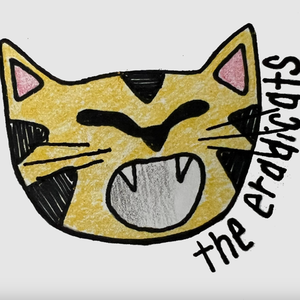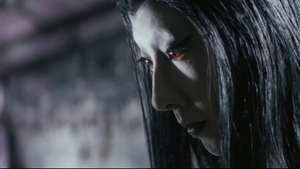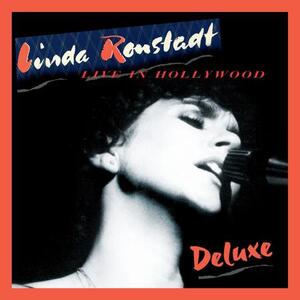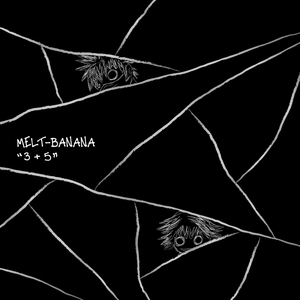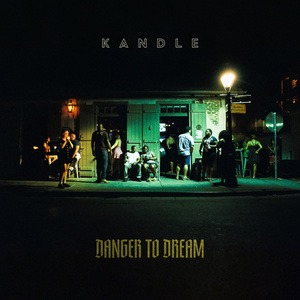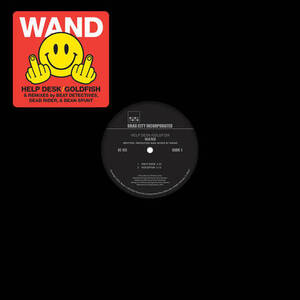“black_title”
Black Tape for a Blue Girl
Dave Aftandilian
Picture yourself waiting for a train at a station. As the wrong train clacks endlessly by, you see the tantalizing reflection of a woman in the window glass. You turn to look at her more closely, but she has already eluded you, ghosting down the exit stairs, leaving you with a just a breath of her perfume and a haunting dream-memory of what might have been. Days pass, but she stays with you as you replay each frame of your (non)interaction with her over and over again inside your head, adding to it bit by bit as your obsession strips you of all pretense of objective distance. You imagine her welcoming you into her life, asking you into her room as she undresses… But you know the “relationship” can never be consummated, even if she wishes it to be, because the woman you think you know is only part of her reality, and you are just a phantom of hers.
“black_sub”
With their latest dark ambient album, As one aflame laid bare by desire , Black Tape for a Blue Girl explores the outer limits of desire and its possibilities for transformation of both the desired and the desiring. The album functions on at least two levels at once. First, as a universal and personal story of a man obsessed by a woman, or perhaps just the idea of a woman, and the change this brings to both their lives. Second, as an homage to and exploration of the ideas of Marcel Duchamp, a French artist whose works inspired much of the album. Although Duchamp experimented with Cubism and Dada, his greatest works – such as The Bride Stripped Bare by Her Bachelors, Even (also known as The Large Glass or Bride ) or Given: 1. The Waterfall, 2. The Illuminating Gas – defy any easy categorization, and presage much of the postmodern art that was to follow them.
I had the pleasure of talking about the new album, Duchamp, and other Black Tape-related issues with Sam Rosenthal, the main creative force behind the group, who writes all their music and lyrics. But this isn’t to say that this is a one-man show by any means – Lisa Feuer’s flutes provide a lovely classical, melodic texture to the album, and images of her grace the CD booklet and inspired much of the album’s lyrics as well. Vicki Richards’ gorgeous, haunting violin lingers in the mind’s middle distance long after the album’s last track has spun its course, and the voices of Julianna Towns (who also plays guitar on the album) and Oscar Herrera bring Sam’s lyrics to ecstatic life.
••
Listening to Black Tape albums, I often feel something of the voyeur, eavesdropping on intensely personal, painful, or ecstatic moments taken from your journals. How do you reconcile the public display/performance of such personal material?
I think that good art is very much derived from intensely personal experience, basically “thrown to the light” by the artist. I feel that the concepts and personal experiences take on a life of their own when they are converted into “art,” so it’s not like I fear it being seen or heard by others. I guess I look at them as separate entities, in the same way that a cover photo begins to represent the music to me, rather than solely being about the person whom the photo is of. I feel the art piece is inspired by the personal, but I don’t have qualms and feel it “should not” be made into art.
On the other hand, the feeling of being a voyeur that you describe is very rewarding to me, because that is part of the idea behind the album… and the fact that you feel that way draws you into the work, making you a participant (as a recipient) rather than allowing you the distance that you might desire.
Aflame seems something of a departure from this pattern, with the lyrics more detached, linked only partly by your life experiences, and perhaps more strongly by references to and interpretations of the works of Marcel Duchamp. Why did you decide on this slightly more distant path to the lyrics for this album?
Hm? I don’t personally feel that the lyrics are more detached than other albums. I see it, rather, as Duchamp’s words often fit within the overall picture of what I am trying to communicate on Aflame ; I appropriate bits and pieces that would help tell my story. I think that things you think are not about me actually are and visa versa. On this album as well as past ones, there are “characters” created within the words, as a way for me to tell different stories. For example, there is one character whom I think of as “the Julianna character” who appears in “Denouement” [on Aflame]. I don’t personally relate to the line “and maybe it’s better to desire than to achieve” – I like having what I desire – but it makes for an interesting personality. So people often assume that something that in reality is not about me, is; while stuff they might think is about Duchamp actually is about me…
Your last two albums, Remnants of a deeper purity and Aflame , both have a very classical feel to me, an intimate, almost archaic atmosphere of gentle beauty and quiet musings more akin to chamber music than ambient. Have you consciously been choosing a more classical sound and set of instruments, or has this just been the result of a natural progression in your music?
I look at it this way: the first four albums were very diverse in the sound of the songs presented. It changed drastically from song to song, which was partially due to the number of different people who played on the records and partially due to learning as a songwriter. The last two have a smaller band line-up who appear on a greater percentage of the songs, which I think helps unify the sound.
That said, I also was intentionally trying for a modern-minimalist approach on Remnants . The archaic feeling on Aflame probably evolved by chance: I bought a new EMAX and it came with a disc of woodwind sounds. The bassoons and oboes became part of the title track, and it really had that “Archaic” feeling. Adding the flute and the violin to that basis creates something definitely un-like “ambient music.” I really haven’t done a lot of ambient songs on the last few albums – unlike The Rope , which was half ambient. Granted, “The Passage” [the most directly “ambient” song from Aflame] is about a third as long as the entire Rope album, but it’s really intended as a musical afterglow…
I think that Vicki’s involvement gives Aflame a classical feel, because she is a classically trained musician – both in Western and in Indian classical music. Certainly I like to feel that I have progressed as a musician and a songwriter, but it really comes down to the fact that I have talented musicians who play on my albums. When I know I have someone as talented as Lisa here, it inspires me to write flute lines for her. And the flute is – by nature – something which requires a melodic line (unlike a keyboard which can drone away very contentedly), so that allowed me to write more melodic parts. I certainly would never claim that I know anything about classical music… so when somebody says my music is classical or operatic, I am usually quick to deny that (laughs).
“black_tape1”
What sort of music have you been listening to lately (aside from Projekt bands)?
Not a whole helluvalot, really. There hasn’t been a new album (non-Projekt) that has blown me away, lately. I have rediscovered Rosewater Elizabeth’s faint album, which is really good!
Black Tape hadn’t done any live shows before the first Projekt Festival in Chicago in 1996, but since then you’ve done quite a few, and are planning on going on the road again this February. What changed your mind about playing live? Do you feel the live format offers you musical opportunities that the studio doesn’t, or do you just enjoy connecting more directly with your fans?
I think that getting out there and meeting the fans is the best part of playing live. Unlike someone such as Steve Roach, who creates new material on the road, I think we are more or less following the script of the songs – and that really isn’t much of a growth opportunity, in that the songs ultimately exist in a more truthful and exact way on the recordings. On the other hand, I do feel that playing live has made me more aware of the structure of my songs, and what it takes to keep a song “interesting” – which I do feel has been incorporated onto Aflame . So it was educational, in that sense. The other fun part about it is seeing the songs come to life… such as when Lisa transcribes a part that Vicki played once in the studio, and then it can exist in flesh on stage – but coming from the flute. This is quite interesting; it gives the music a reality that wasn’t previously there for me.
Do you see much of a link between the aural and visual arts – do you, for instance, hear music when you look at certain paintings, or see pictures when you listen to or compose music?
Yes, I think there is a definite connection that I would love to explore – either in video or in a stage creation for the songs. Playing live in clubs has its own special charm, but I would rather be able to create a multi-media piece to truly represent the album. Something that could incorporate some live performance and some pre-recorded bits – such as what Laurie Anderson does. That is definitely a goal for the future.
In much of Duchamp’s work, the interpretation lies in the eye of the viewer (assisted, in the case of The Large Glass , at least, by his notes and sketches from The Green Box ) – in a sense the meaning is like The Bride , eternally about to become, but never quite reaching that state of questionable bliss. “The Passage” from Aflame certainly has that feeling to me; an intensely personal journey that each listener must take and interpret on their own. What do you hope the listener brings to Aflame , and what do you hope they take away?
Well, Duchamp was attempting to get away from what he called “retinal art” – which is the art that makes your eyes happy, but stops from entering your mind and causing thoughts. He preferred art that challenged your brain. “What does it mean?” “What could it mean?” It is very interesting, but does require effort on the viewer’s part. This is similar (for example) to the theories and writing of Marshall McLuhan, where the reader is forced to come at least halfway (and often further), and think and reason within the framework the creator provides.
I think that Black Tape isn’t about pretty poppy love songs and three minutes of chewing gum. It has love in it, but it requires the listener to come to the table with the desire to explore and interpret. I hope that they take away a new view on the things I am talking about. I can’t really explain what it is that I hope they come away with, that is sort of specific to each of the listeners… I don’t think art should be a sledgehammer, it should be subtle and creep into your mind…
In the composer’s notes to Aflame , you say that one of the album’s main themes is “looking at desire as a catalyst for transition.” Can you say a bit more about this, and how it relates to Duchamp’s Large Glass / Green Box and Given ?
With the songs, I often created with the mindset that these were “characters” I was writing about… rather than the usual “singer writing a song about himself” that is the custom in rock music. There are elements of my feelings in all the songs, and also elements of what I would imagine these characters were thinking. Each song can be read – more or less – as relating back to the main theme of the album; sometimes they are like different examples of desire serving as the catalyst.
I read Duchamp’s Bride [The Large Glass] as a piece about desire, both in the form of the bachelors desiring the Bride and also in the Bride desiring to consummate with the bachelors. She is at the apotheosis of her virginity, in the sense that she is about to make the transition to “wifedom” from “bridehood.” I think that this desire of hers is more important than the simple interpretation that it could be a piece about the lust of the bachelor. In his own way, I think Duchamp took that desire as a natural fact, and he was more concerned with the complex desire of the Bride. His notes from The Green Box on that subject make up the prose that comes in the booklet before that song.
Given seems to me to be Duchamp’s reflection on the consummation of the Bride’s desire… almost like one is the “before” and one is the “after.” Although some people harped on Duchamp for making such a “retinal” work… I think that it still forces the viewer to think. First from the shock of the actual visuals they see… and then to try to come to terms with the piece, in respect to his other work. I suppose that my song “Given” is about the thoughts of the Bride, before she is taken and enters the realm of the piece Given .
Another theme to Aflame – or perhaps more accurately, working method – is the notion of viewing/(over)analyzing an event through successive frames, akin to stop frame clicking on a video, but with the motion continuing even during the still frames after each click. Successive photos of Lisa’s movement across the CD booklet seem to express this notion, as does the construction within and among the songs themselves. This, in turn, reminds me of Duchamp’s Large Glass , both its division into two “frames” of bachelors below and Bride above, and the three “frames” of heater-induced “Draft Piston” movement set into the Bride’s “cinematic blossoming”/being stripped bare. The same framing notion also can be seen at play in the way Duchamp forces the singular viewer permitted at a time to experience Given , in which the viewer approaches the wooden door, glimpses the eyeholes, and peeps through them at the nude beyond. Did you alter your compositional methods to achieve this effect?
As far as the music goes, no… there was no real alteration of my compositional method. I still began with a blank slate and collaged sounds and chords together. On the other hand, I would say that there was an alteration in the writing of the lyrics and the melodies. In the past, I would rely on journals of my own writing (stuff from my life). This time, I spent time in my journals rolling the concept of the album around, looking at it from different angles and seeing what I wanted this album to be about. There was definitely more thought involved in designing the concept… and when I created my electronics for the song, I would let the keyboard run in repeat mode, while I picked from the “task jar” for a song subject. I would then see how I could make it work with that music.
Often those songs came from my ideas about Duchamp… and then I would blend that with experiences and ideas of my own…
“black_tape2”
In a lot of modern and postmodern art, process is at least as important, if not more so, than product – both the process of creation and the process of viewing/interpreting. Certainly this seems to be true in many of Duchamp’s works, which evolve over years of incredibly detailed composition (for The Large Glass ) or decades (for Given ), and which require the viewer to complete the process of creation in viewing/interpretation. Do you feel this applies to Aflame as well?
In a certain sense yes, that one hopefully thinks about the subject and completes ideas that are in fragment form within the words. It is music that can be thought about and serve to create new ideas and thoughts for the listener, yet it also functions as a complete auditory experience. I think that Duchamp’s work suffers for viewers who have no idea what the work is about. I have gone to the Philadelphia Museum of Art many times, and noticed how people sorta breeze through the Duchamp room, once they pass the paintings… because then it “doesn’t make sense” to them…
On a different note, Black Tape for a Blue Girl just got booked to play at the Philadelphia Museum (which houses the permanent Duchamp collection). I am very excited about that!
What do you think of the following Duchamp quotes (the first taken from his lecture “The Creative Act” [1957], the second from an interview published in the spring of that year):
“[T]he creative act is not performed by the artist alone; the spectator brings the work into contact with the external world by deciphering and interpreting its inner qualifications and thus adds his contribution to the creative act.”
“It is the spectators who make the pictures.”
I agree with him, at least in so far as modern art goes. You are supposed to sit there and think about it, and use your internal set of standards and emotions to derive a “meaning” from the piece. I find that to be something very exciting about art; but on the other hand, I often feel that postmodern art doesn’t have the intellectual core it likes to pretend it has. I think it is often putting one over on the viewer, even though (of course) many people thought the same about Duchamp in his time.
Although there are a fair number of works of poetry based on artworks in other media, there seem to be relatively few musical pieces devoted to art in other media. Do you think Duchamp’s work is particularly conducive to musical “inspiration,” and if so, why?
I don’t think it is something that someone would have thought of doing, so probably it is not the most conducive oeuvre of artwork to write music about. I don’t know if (without the words) you would think this music is about Duchamp – such as if it were instrumental. That said, you are correct that there are not many musical pieces based on visual artists. Lou Reed/John Cale’s Songs For Drella is an example that springs to mind… and one that I think is quite successful…
Most of the songs on As one aflame have a relatively direct link to the works of Duchamp, or at least an inspirational link to his works. However, the masochistic (literally – some of the lyrics are paraphrased from Venus in Furs by Leopold von Sacher-Masoch) scene portrayed in “Tell me you’ve taken another” seems to be an exception. Can you say a bit about how this song fits into the album as a whole?
Well, maybe it doesn’t? It fits into the overall theme, in so far as it is a story about a character who is expounding upon his desire. However, it doesn’t really have anything to do with Duchamp. On Remnants of a deeper purity , the song “For you will burn your wings upon the sun” was about a character who was destroyed by his lover’s betrayal. People seemed to like the over-the-top nature of that piece, so I decided to write a companion piece. Somehow I decided to do a song that was the direct opposite, about someone who wants to be betrayed. Someone who enjoys that feeling. That is how the song evolved…
Finally, can you recommend some books and Web sites to folks who would like to delve more deeply into the works of Duchamp?
The book that most directly reflects upon my album is The Private Worlds of Marcel Duchamp by Jerrold Seigel (University of California Press, 1995).
• •
For WWW information about Duchamp, and photos of his works: http://www.freshwidow.com (nice images, including an animated “walk” up to and through Given , and a good chronology)
http://galaxy.cau.edu/tsmith/Duch.html (interesting discourse on The Large Glass , etc.)
For more information on Black Tape for a Blue Girl: http://www.projekt.com/bands/btfabg.html ◼






